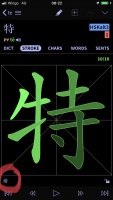Hi,
1. Why is the word 里 is written as 甲 first followed by 二? I've always written 里 with 日 first, then 十,and finally 一 at the bottom. I found out the order of my strokes are incorrect according to Pleco.
2. Why is the word nine 九, is written with 丿first then 折 zhe where as the word 力 power,is written with " 一 亅" first, then followed by 丿? 九 and 力 both have two strokes, but the order of 丿is written first in the former, i.e. 九。
Thank you,
Melissa.
1. Why is the word 里 is written as 甲 first followed by 二? I've always written 里 with 日 first, then 十,and finally 一 at the bottom. I found out the order of my strokes are incorrect according to Pleco.
2. Why is the word nine 九, is written with 丿first then 折 zhe where as the word 力 power,is written with " 一 亅" first, then followed by 丿? 九 and 力 both have two strokes, but the order of 丿is written first in the former, i.e. 九。
Thank you,
Melissa.

